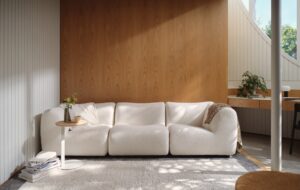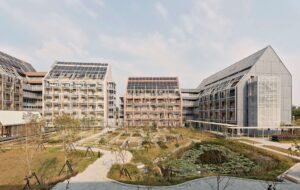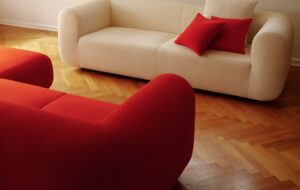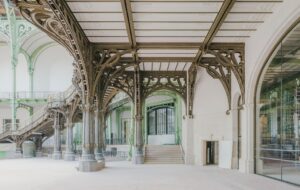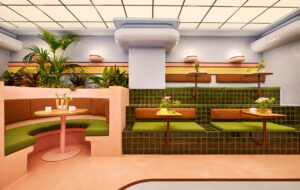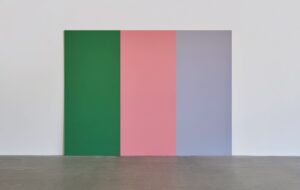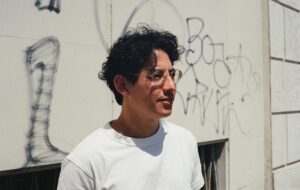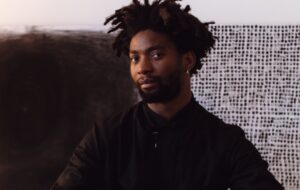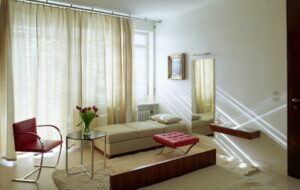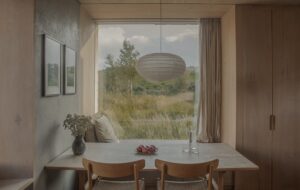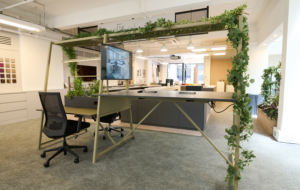

words Beatrice Galilee
“It’s impossible to look bad in this building,” announces UN Studio co-founder Ben van Berkel as he stands at the top of the spectacularly pink stairwell of the Theatre Agora in Lelystad. “Everybody looks good here.”
He and Caroline Bos, his business partner and wife, are preparing to show local politicians and dignitaries around their new theatre, which is part of a major regeneration masterplan by landscape architects West 8. The founders of the 80 strong practice, United Network Studio, formerly van Berkel and Bos, are based an hour or so from here in Amsterdam. The pair – one architect, one writer – first made their mark as part of the wave of “SuperDutch” architects in the late Nineties. Alongside Rem Koolhaas’ OMA, MVRDV, Wiel Arets and Mecanoo, they contributed to a fearlessly enthusiastic architectural and political climate in the Netherlands, building confidently and expansively to the envy of much of Europe.
Whilst many of its contemporaries were concerned with producing manifestos related to urbanism and social housing, UN Studio stood out for its fascination with digital technology and the fold – in this sense its practice was closer to those of form makers such as Zaha Hadid and the Americans Greg Lynn and Peter Eisenman. The studio’s most important early work was the twisting Mobius House (1998), designed for a young couple, the interior loops and folds of which established the potential for a concrete space with no conceivable beginning or end. This notion was explored further in both the widely published Mercedes-Benz Museum (2006) (icon 037) in Germany and the recent Villa NM in the US. The central public space of this latest project in Lelystad is part of the same story.
“This is where it all began,” says van Berkel, running his hand along the handrail as we descend the wide white steps to begin the tour of the building. “I thought, would it not be beautiful if you could touch the concept of the building, a handrail that guides you up and orients the way you float in that space? You step onto it from the foyer, it takes you to the theatre and then it turns into the skylight.”
The candyfloss-coloured handrail twists from the folding steel facets of the roof, then slowly wraps back down two levels to the column-free space of the ground floor cafe. Its intense pink is peculiarly calming, tinting our skin, absorbing colours and reflecting onto walls and stairs. It changes from violet to magenta as we walk down towards the foyer and then outside, where the kaleidoscopic orange, yellow and ochre facade shouts against the bright blue sky and the surrounding townscape.
Although the building will no doubt contribute to the appeal of this drab post-war town and begin to put it on the map, UN Studio doesn’t see its architecture as an object or a catalyst for regeneration. For van Berkel and Bos, the Agora’s faceted shell and the spaces and folded forms it preserves have the inherent complexity and depth of the plays and performances within the building. “So many architects are interested in the cinematographic – observing and reacting to a building,” says van Berkel. “For us, the building itself should be the camera.”
This is the key to van Berkel and Bos’ work. The form is a somewhat secondary aspect as their buildings attempt to carry a highly considered virtual quality where the architecture is planned as part of a larger network of maps and diagrams. Increasingly, as in many offices around the world, they are keen to emphasise that much of their studio time is committed to research. “Of course Bernini had 40 researchers,” admits van Berkel, “but perhaps they were looking at different types of marble. Now the position of the architect is changing – before someone asks you a question you need to have prepared five answers. You work very much like a fashion designer.” Speaking quickly, arms gesturing, he embarks on a long analogy about fashion and research, which perhaps stems from his teenage daughter’s recent move into the fashion industry.
UN Studio’s built aesthetic has often been described, and particularly in relation to the Mercedes-Benz Museum, as baroque. The viscous draping walls and ceilings embraced by architects in the 18th century in search of movement and drama were a reaction to the structure of Renaissance classicism. Three hundred years on, van Berkel and Bos are similarly frustrated by the repetitive square forms and grids of modernists and minimalists, but they do not reject the philosophy behind them – they often describe Mies as “overrated” but appreciate the motivations and strive for an architecture without historical references.
UN Studio’s formative years were in London – Bos studied art history at Birkbeck College, while van Berkel was at London’s Architectural Association under the watchful eye of Zaha Hadid. “The last year with Zaha was amazing. She pushed us all to draw bigger, but it was so much more than painting – it was discussion, theory, engineering and a search for a new kind of spatiality,” says van Berkel. “There were six of us in her studio, and I used to get a call around 7pm to go over to her house and she’d say, ‘Bring a chicken.’ We’d all cook and talk about our work. It was just great.” But whilst Hadid at the time was limited to paintings, van Berkel and Bos had no intention of being paper architects.
After graduation the pair moved back to Amsterdam and quickly began with a number of commissions for exhibition design from curators who were impressed by the unusual combination of architect and writer. Their career kicked off with the Erasmus Bridge, now a symbol of Rotterdam, in 1996. In later projects, they began to experiment with colour. The Galleria department store (icon 019) in Seoul, completed in 2004, is lit by thousands of coloured LED lights behind 4,330 glass discs, while La Defense (icon 017) in Almere has a sparkling glass facade coated in dichroic film (more commonly used to coat perfume bottles).
After images, all-encompassing spaces and unnerving scenarios with spectacularly cantilevered walls and undulating floors are trademark UN Studio. They are present at every scale, from exhibition designs to the masterplanning of Arnhem station and the Aarhus harbourside. Such projects use digital, parametric design techniques – an important part of UN’s practice. “We are often put in the computer corner,” says van Berkel, but he doesn’t like to be defined by such techniques. “We are interested in what computers can do and use them as a tool for our imagination.”
On a smaller scale, van Berkel is working for Alessi to design a new range of glasses that he’s particularly excited about. “There’s one glass for cocktails that is very flat and thin – you can only put a little cocktail in it and you have to lick it off. Alessi went crazy for it,” he laughs. “I still have to do all the other 25 glasses though … it seems that the smaller things go as slowly as the bigger ones.”
This is one of the few projects van Berkel has worked on without Bos. The collaborative way in which they work hasn’t changed – van Berkel the architect and innovator working closely with Bos the critic and thinker. “I think we are more interested in what the other does than in our own work,” laughs Bos warmly. She is quiet but sharp and attentive. Van Berkel talks almost continuously, answering questions keenly and articulately but with pauses to smile at his wife – they compliment one another frequently. “I am always saying Caroline is the better architect. She is the best trendsetter I know,” says van Berkel. “She reads all the papers everyday. I read two – she reads five. She makes a lot of links that I just can’t do.” Bos, as well as writing for the studio, leads the analytical research and diagramming, connecting needs and missing elements, examining sites. It’s a role that many practices wish they had time for.
“We changed from van Berkel and Bos to UN Studio because we believed that the tradition of the architect’s office was so boring, and the system of architect and project architect didn’t work,” says van Berkel. “Caroline and I are really advisors to the team. We discuss what we shall do with a particular location. I’ll scribble and sketch but then Caroline will come in and discuss how we programme. It goes back and forth like this. Design comes very late with us.”
Van Berkel has tutored at universities in the Far East, the US and Europe. “When I teach I want them to learn the essence of what architecture is. I want them to discover it.” He likes to make links to product design and fashion to show his students the potential for radical design. “When the iPod came out it was such an alien – I really didn’t know what it was. It proved to me that still in design you can be brave and it made me believe in the new.”
Back at the Agora, the blood-red heart of the design is the 750-seat theatre itself – faceted acoustic panels, each one a perforated plywood plank in a subtly different tone of red, reflect and diffract sound across the room. The seats are designed so as not to deaden any noise from the stage and the cedar boards of the stage itself are large enough to hold a Russian ballet. Somehow this room is like the centre of a deconstructed ruby, designed to dramatically project sound across, around, behind and above the audience, demonstrating UN Studio’s notion of all-encompassing space. “I worked on this space more than any other in the building,” says van Berkel. “If you love music you want it all around you.” The effect certainly works – the clarity of a small rendition by a local choir was quite fantastic.
We move on to complete the tour of the building past the two further practice rooms and one of three spectacular open foyers – where the vivid orange, steel and aluminium facade enters the interior of the bar. We find our way into the artists’ lounge, where bamboo tables look out over the town. “I read something really crazy the other day,” says van Berkel. “Apparently, if you have a foot massage twice a week you add two years to your life – because from the foot you can reach everything in the body!” He is pleased with this fact but then considers it a little more. “You know, in architecture we haven’t discovered the foot yet. Maybe it’s somewhere else…” Perhaps it’s in the handrail? “Yes,” he muses, “perhaps.”

